Few Search Engine Optimization (SEO) strategies are as discussed or debated as much as link building, and for a few good reasons. Despite some claims to the contrary, link building remains an integral part of SEO—so it’s always relevant in discussion. Thanks to Google’s Penguin update (and subsequent updates), the process of link building in SEO has changed dramatically over the past decade—so it’s in a state of evolution. And it’s less precise and calculable than certain “gimme” SEO strategies like ensuring your onsite SEO success is in order—making it more uncertain to many practitioners.
On the surface, link building seems so simple, so how can it be so complicated?

(Image Source: Moz)
The apathetic marketer will denounce link building as being too complex to approach, and the frugal marketer will see the costs of link building—which often run up to thousands of dollars per month—and immediately write it off as too expensive. But the reality is, link building is incredibly valuable, usually worth far more than the money you put into your campaign. Yes, I’m biased, but if you break down the benefits, the actual value of link building is more or less provable.
Contents
The Trouble With Pinpointing an Exact Value
I’ll make this statement early, so you aren’t misled. I’m not going to be able to put a firm numerical value on “link building” or the value of a single link, or anything like that. Pinpointing an exact value is incredibly difficult, if not impossible, for the following reasons:
- Ambiguous authority measures. Domain authority (and subsequent ranking power) is one of the most important benefits of link building—you can measure it easily with any number of online tools, often for free.
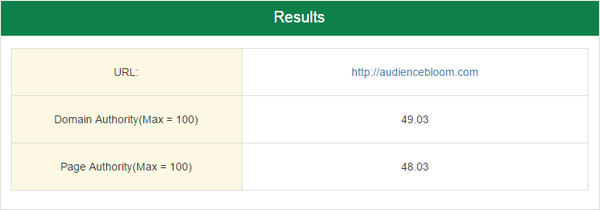
(Image Source: Small SEO Tools)
With link building, you’ll be able to track gains in your website’s authority, but it’s almost impossible to correlate these to individual links or efforts in your strategy.
- Unpredictable variables. Assuming you could calculate the precise value of link building, there’d still be a problem with projecting its overall value—unknown and unpredictable variables. How many people will see your offsite article? Will your publisher replace your link with a nofollow link? How long will it stay up?
- Peripheral values. Link building has a number of calculable values, but also some incalculable values, such as visibility and reputation increases. This complicates our ability to measure the value of building links.
- Overlapping influencers. Despite being one of the most important SEO strategies, link building is still just one strategy. In conjunction with onsite efforts and ongoing content, it’s hard to isolate which influences came exclusively from good link building.
- Long-term gains. This is a long-term strategy, so measuring your short-term gains isn’t enough to give you an accurate depiction of your overall earned value. By extension, it’s almost impossible to project your growth over subsequent months and years.
- Strategy variation. This should go without saying, but every business is different, and will need a different strategy to be successful. Some of these are more expensive than others, and some yield more value than others.
With those considerations in mind, let’s take a look at exactly how valuable a link building strategy can be (within the limits of our understanding).
Anatomy of a Modern Link
First, it’s important to know exactly what “modern” link building is, as there are still a number of misconceptions and poor descriptions of the strategy floating around. Manual Link building used to be pretty simple—you’d post links pointing back to your domain wherever you could, sit back, and reap the benefits. Today, Google knows the difference between a good link and a bad link, and publishers are ever watchful for links that are only used to manipulate rank or increase website traffic.
Modern link building is somewhat straightforward, but it isn’t easy. There are two main approaches. The first is direct and controllable; a domain produces valuable content that an external publisher would like their audience to read. The content contains a number of links, one of which points back to the author’s domain, and when posted, the link goes live. It’s not a form of manipulation or deceit because the primary goal is writing good content for the publisher’s audience.
The second approach is more about attracting links naturally. With this method, you’ll produce an extraordinary piece of content, syndicate it, and hope it goes viral, getting shared by thousands to millions of people. When this happens, you’ll naturally earn dozens of links pointing back to you.
Main goals
So, with both of these approaches, you have a handful of important goals. These goals are the “value” that link building provides. I’ll introduce these values as general concepts here, then dig into them in dedicated sections.
- Authority. Google uses inter-domain links as third-party verifications that a site is authoritative. The understanding is that an authoritative site will only link to a domain if that domain rating is trustworthy; using advanced algorithms, Google can trace link networks and site relationships to evaluate which domains (and web page) are most trustworthy. The further away you are from a trustworthy site, the less authoritative your site will be.

(Image Source: Moz)
Authority is important because it determines your ranking potential. Assuming a user query is relevant to your site, your domain authority will determine how you rank compared to other websites. Getting more links from more valuable sources will therefore rank you higher, and earn you lots of additional organic traffic. Every visitor to your site is valuable.
- Referral traffic. Search-based organic traffic isn’t the only traffic that link building provides, however. You’ll want to target valuable publishers, as they’ll give you the most authoritative links, so naturally, these valuable publishers will have a dedicated readership. Anyone who reads the blog post and is intrigued to learn more may follow your link directly, getting to your site as “referral” traffic. Think of this as a secondary way for new users to get to your site from link building. Though standard links are more valuable due to the authority they pass, even nofollow links can generate traffic. You can measure both Organic and Referral traffic using Google Analytics.
- Brand visibility. Brand visibility is a secondary consideration, because it isn’t objectively measurable the way your search ranks and referral traffic are. For the most part, you’ll be publishing content as a personal brand affiliated with your corporate brand, which gives you additional exposure to new markets on each new publisher. Even if you aren’t, you’ll get an opportunity to make your brand visible when you introduce the link. Brand visibility alone won’t bring you much value, but visibility leads to awareness, which leads to consideration, evaluation, and eventually loyalty—it may even help you earn some word-of-mouth referrals!
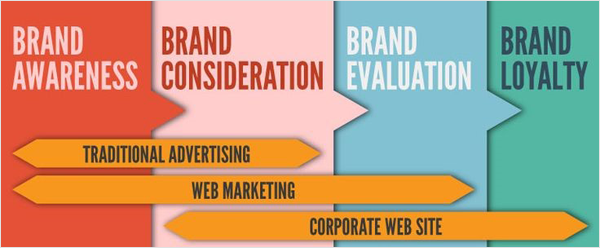
(Image Source: Pinterest)
- Tangential benefits. In addition to the benefits above, there are some tangential benefits to link building. These are less reliable and tougher to measure, but they do have a positive impact on your brand and your bottom line. For example, the strength of your content may serve a value to increase your brand reputation, positively associating your brand as a thought leader in the industry. People may socially share or link to your externally published article, sending more secondary link juice your way. And of course, most publishers socially syndicate your article anyway, earning you more total exposure and possibly an increased social media following.
Not all links are created equal
Of course, it needs to be acknowledged that not all links are the same. In fact, a bad link can actually hurt you by earning you a penalty or sinking your domain authority. I’ll get into the costs of negative link building on my section on Authority, but before I go any further, it’s important you understand the variables at play here. A link on a local news site won’t pass nearly as much authority or see nearly as much traffic as a link on a national publisher’s site—but the latter is, of course, far more difficult to earn. It takes much better content, foundational authority, and a solid understanding of the publisher’s target audience to get accepted.
Accordingly, the value of your link building campaign depends greatly on the value of the links that comprise it.
Authority
Let’s take a look at the domain- and page-level authority influences that link building has, and how that translates to an actual value.
Link Building as a Necessity for SEO
First, let me explain why link building is important to any SEO campaign. Quite simply, without some link building measure, it’s impossible to gain any significant rank in Google.
Take a look at the relative influence of ranking factors, according to correlational studies by Moz and SearchMetrics:
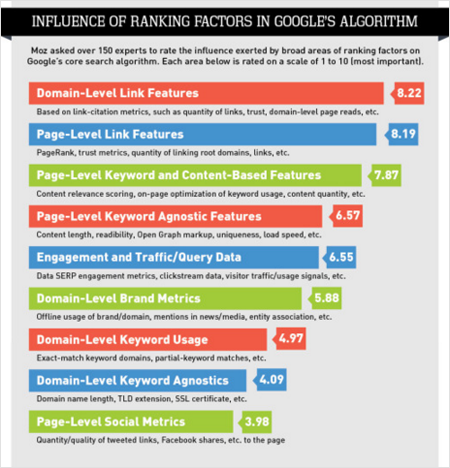
Take a look at the top two most important influencers. Don’t let the technical descriptions fool you. These two entries refer to links pointing to your domain and links pointing to your individual web pages in question. Links are even more important to rank than keyword- and content-based features, and more important than page-level keyword-agnostic features. Some of the most important factors of SEO still pale in comparison to the influence that link building has on your overall ranking potential.
This has been shown in a number of independent studies, and suggests that the quantity and diversity of your inbound links directly predicts how you’ll rank for a relevant query:
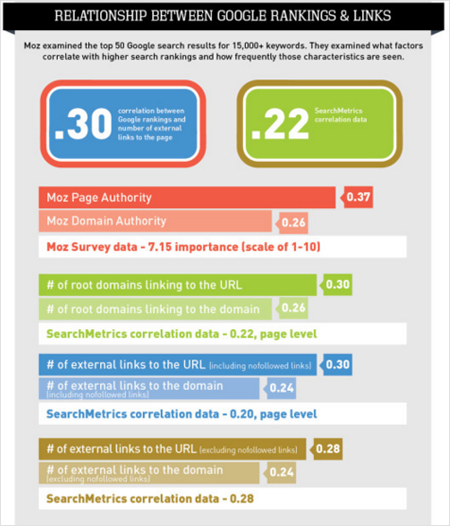
Unfortunately, this correlational data can’t tell us the amount of ranking influence a single link has, but the takeaway that broken link building is a necessity for earning higher ranks is what we’re after in this section. The bottom line: SEO is not possible without link building.
The Value of Higher Ranks
Now that we know SEO depends on link building, let’s take a look at the value of SEO. As an abstract concept, SEO seems valuable—you, like every other modern consumer in the United States, often consult search engines when you’re making a buying decision. That means any increase in search results visibility you have has the potential to be valuable.
There are too many variables to try and isolate any search conditions or direct values—a high rank for a nationally relevant, broad keyword will result in far more traffic than a high rank for a local niche keyword. However, in the case of the latter, it will be far easier to rank. Anecdotal evidence suggests it’s possible to earn 100,000 organic visitors a month or more—but what can you reasonably expect?
First, recognize that there’s are some steep cutoffs when it comes to the payoff of search rank:
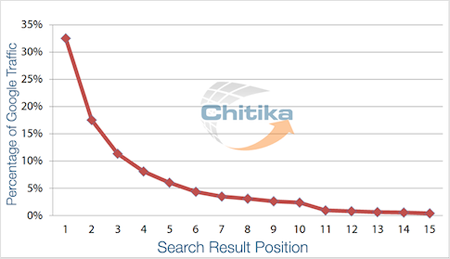
(Image Source: Chitika/SearchEngineWatch)
The vast majority of searchers click on the first site that comes up for their query. This means that, all other things being equal, it’s better to have one or two positions as number one than it is to have dozens of positions on the second page or lower. With the right keyword strategy, your link building techniques can support this upward momentum, helping you to cross the tough thresholds from page two to page one, and up each additional rank.
Value of a Single Link From a New Domain
It’s hard to say exactly how much value a new link can generate for your brand in terms of authority and rank. If you somehow earn a link from a high-authority national site like Huffington Post while you’re still in your infancy as a brand, you could easily move up several points in terms of domain authority, resulting in a kind of “rising tide” that increases all your ranks significantly.
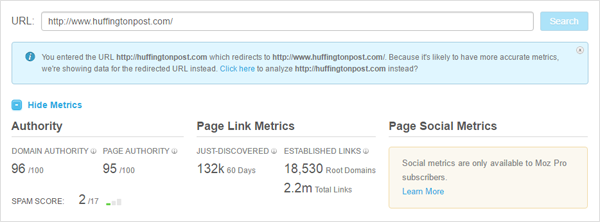
(Image Source: Moz)
On an iterative scale, any link from a new domain could be the one to bump your keyword ranks to the next level.
So let’s run a quick thought experiment as an example. Let’s say you have a modest range of targets—three keywords that each receive about 30,000 searches per month. You currently rank on the second page for all of them, getting almost no traffic whatsoever. In month one, you earn high quality backlinks from three new domains and you move up to position 5, which gets about 5% of all traffic (according to the graph in the previous section). That earns you a total of 4,500 monthly visitors for as long as you maintain this rank (we’ll project this indefinitely). If your conversion rate is even 2%, that’s 90 new conversions from the authority boost of your links alone.
Now, this model doesn’t account for the time it took to get to page two, nor does it account for the even more massive link to the top spot—which multiplies your traffic sevenfold. It would also take some pretty strong domain links to jump five positions in one fell swoop for what are probably highly competitive keywords. Take this illustration for what it is—an indication of potential. Without any link building, you forfeit that potential.
The Cost of Negative Link Building
This doesn’t mean that you need to build as many links as possible, however. Be aware that there is a sliding scale for link quality, and that scale runs into the negative; building a bad link won’t just stop you from making progress, it could easily reverse some of the progress you’ve already made. Your domain authority will suffer, and you may even incur a manual Google penalty.
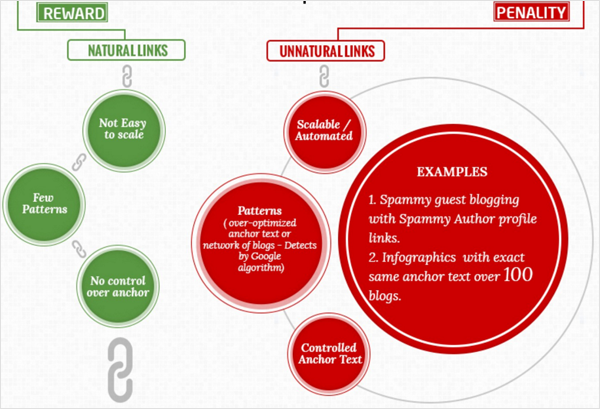
(Image Source: Visually)
There are many link building companies out there who try to make a quick buck by building “bad” links. Not all of these are malicious, per say, just misinformed or misguided. If a link building service is suspiciously cheap, there’s probably a reason for it. Good link building—the kind that actually can earn you sweeping changes in rank—demands experience, investment, and effort, and that costs more money. Though some agencies have higher profit margins than others, as a general rule, you get what you pay for.
Recurring Value
Finally, a quick note about the recurring value of authority and organic traffic. When you earn authority, as long as you don’t commit any egregious offenses, it’s hard to lose that authority. Other competitors may wrestle with you over individual positions, but for the most part, your ranks are earned. You don’t just earn organic traffic for a few days or a few weeks—as long as you maintain your link building strategy, you’ll reap organic traffic month over month, indefinitely, adding to the value of your efforts.
Referral Traffic
All the benefits and value I described in the preceding section is just one of the two concrete ways your link building strategy will earn value in the long term. The other is through referral traffic. Though the concept of referral traffic is simple (the number of people who click through your established link to your domain), the execution and variables surrounding it makes it hard to estimate a concrete value. We’ll strive for a reasonable estimate.
Publisher Traffic
The first and most important determining factor in how much referral traffic your inbound links can generate is the amount of traffic the publisher receives. Assuming you’re getting a spot on the front page or in your industry section of choice, you’ll earn a fraction of the monthly visitors to that section. It’s hard to say definitively, but once you’ve published 4-5 articles on a given source, you’ll have a reasonable estimate for how many visits an article on that source can generate.
Publisher traffic varies wildly, and may change without warning. For example, Huffington Post’s estimated monthly unique visitors is on the order of 200 million, but that number tapered off dramatically when BuzzFeed emerged as a serious competitor. There’s no way to speak generally and accurately about this, but your first circle of external publications will likely generate links very little in terms of referral traffic. Once you earn enough authority to post on national-level publishers, you can count on hundreds to thousands of unique referral visitors to your site every month.
Informational Value
The type of link you offer has a significant bearing on how much referral traffic you earn as well. For example, if you simply have your clickable link as one of several examples, buried deep in your content, few people will venture to follow it. On the other hand, if you make reference to a much larger issue, or a separate study, that your link provides access to, it’s likely you’ll pique your readers’ curiosities enough for them to follow it. Your wording and persuasiveness also come into play here, just as they would with a traditional call-to-action. This could mean the difference between earning 100 referral visitors out of 1,000 readers and earning 500.
You’ll need to keep a careful balance here. If you make your internal links and external links too persuasive, too obvious, or too geared toward attracting new traffic, they’re liable to be rejected by the publisher—especially at the higher levels. If you make them too “hidden” or innocuous, you’ll miss out on tons of traffic.
Traffic Optimization
It’s also worth noting that not all traffic will yield the same value for your brand. You may get 500 visits from a high-level publisher, but if you write for a general audience, you’ll get people who are only fleetingly interested in your business. On the other hand, if you earn 100 visits from a niche industry publisher, you may end up with 100 potentially interested customers.
Again, you’ll need to strike a balance here. If even 25 percent of those 500 national visitors are interested in your products, you’ll earn more total value than with your niche publisher. Maintain a blend of link relationships with different publications to maximize your value, and understand that not every “visit” can be calculated to have the same potential value.
Recurring Value
The timing aspect of link building is also important to consider. Most “new” posts get an immediate surge in popularity, earning the majority of their lifetime value of traffic within the first week of publication. However, don’t forget that online articles usually remain up forever, along with whatever links you’ve built to go along with them. If your content is evergreen, you can feasibly syndicate it on an ongoing basis for the foreseeable future, reaping more and more social and referral traffic as new people discover your content. If you land a breakout piece, this effect is multiplied, as your offsite article will start ranking high for related searches and earning regular organic traffic that could filter into referral traffic.
Total Referral Value of a Link
Much of the “total referral value” of a link depends on the value of an average visitor to your site (just like organic traffic). If you have a 1 percent conversion rate and a $100 value of conversion, then each visitor is worth an average of $1 to you, excluding some of the variables listed above.
I’m working under the assumption that your traffic has some value, let’s say $1 per visitor, and that you’re link building on a national level, where it’s possible to earn hundreds of visits in referral traffic for every new post you create. With strong content, strong link placement, and strong publishers, every link you build could yield hundreds to thousands of dollars’ worth of referral traffic. The only caveat to this is the understanding that it usually takes time to work up to this level, meaning the value of your link building strategy increases based on your commitment to it.
Brand Visibility and Tangential Benefits
Though the tangential benefits of link building are difficult to measure, they’re worth acknowledging, since they can affect you in real ways.
Brand Mentions
Any mention of your brand on an external site is going to increase your brand visibility in some small way. A flippant user may not register your brand name or follow your link, but the next time they see you, they’ll remember seeing you in the past. They may even mention your name to a friend or family member thinking of making a purchase in your niche. Brand awareness isn’t as concretely measurable as referral traffic or organic traffic—in fact, it’s usually invisible—but it can push unfamiliar consumers closer to becoming actual customers.
Personal Brand Reputation
When your personal (or corporate) brand posts on an external publisher, particularly a reputable one, you’ll immediately get a boost to your reputation by sheer affiliation. Take a look at just some of the places where AudienceBloom team members have been published:
Being featured on any one of these publications makes your brand seem more authoritative, and listing all of them out like this makes a powerful first impression. Inbound users will instantly grow more familiar and trusting of your brand.

Social Traffic and Engagements
For the most part, publishers will work to syndicate your article on their own social accounts. Take Entrepreneur as an example:

(Image Source: Twitter)
In many cases, they’ll call out your own brand’s social media information, and might even link to your site depending on the circumstances. This could lend you social traffic to your site, more social followers for your brand, or just more opportunities to engage socially with your readers. You can even jump into the comments section on your post and engage with your users to build stronger community relationships. Again, the value here isn’t precisely calculable.
Growth Factors and Relationship Value
When it comes to starting, growing, and maintaining your strategy, you’ll find a handful of variables that influence how much value your link building campaigns actually return.
Single-Source Returns
When posting new links on the same domain, there’s a law of diminishing return when it comes to domain authority. It’s far more valuable to earn links on new domains than it is to earn successive links on the same domain. However, the referral traffic value remains constant—and may even increase as you earn more loyal readers. It balances out so that there’s only a slight decrease in value with successive link building opportunities.
Higher Authorities
Getting yourself published on one high authority gives you more credentials to post on similarly high authorities—or even higher ones. This makes even small-level link building opportunities valuable just for the fact that they can lead to high-level link building opportunities. You’ll need to bear this in mind, especially in the beginning of your campaign.
Ease of Entry
To build links effectively, you need stellar content, great relationships with high-level publishers, and an intimate understanding of what makes a “good” link. It often takes years to build up these credentials on your own, meaning you’ll probably be operating with negative value until you cross a certain threshold of experience. Fortunately, there’s a shortcut to this—partnering with an experienced firm who already has the relationships, knowledge, and capacity to execute this work on your behalf.
Putting It All Together
There’s a lot of information in this guide, but I’ve intentionally stayed away from pinpointing a solid number value, for reasons that should be apparent to you by now. Still, I’d like to conclude this resource by attempting to definitively estimate—or at least describe—the real value of a link.
The Real Value of a Link?
In the later stages of a link building efforts, when you know what you’re doing, have existing relationships with publishers, and have the potential to work with high-authority sources, the value of link building is enormous. Assuming you remain consistent, with a targeted strategy, it’s possible for link building to directly influence thousands of organic visitors and thousands of referral visitors per month—even in exchange for moderate effort—and that’s not even counting the indirect benefits. At this level, a single link, accompanied by good content, can yield up to thousands of dollars in value.
The only real problem is getting to that level. Unless you want to spend years and thousands of man-hours inching your way up, there’s only one ideal solution to see this return.
The Value of Outsourcing
You know that low-quality link building, or cheap link building will only hurt you in the long run, but the hundreds to thousands of dollars a month it costs for an experienced link builder seems excessive on the surface. But remember, you’re paying for your backlink outsourcing partner’s experience. You’re paying for their relationships. You’re paying for their quality. It’s a big investment that yields a big return, as you’ve seen in my illustrations and examples. If you don’t engage in link building, you’re leaving those thousands of recurring visitors on the table.
If you’re interested in starting a link building campaign for your company, contact us for a free proposal.
Want more information on link building? Head over to our comprehensive guide on link building here: SEO Link Building: The Ultimate Step-by-Step Guide
Tim has spent more than two decades in organic online marketing, working with some of the most well-recognized online brands in scaling their content marketing campaigns.
Connect with Tim on Linkedin & Twitter.
- Is Your SEO Agency Doing a Good Job? Here’s How to Tell for Sure - May 1, 2024
- Why Linkable Assets are the Key to Successful Link Building - April 1, 2024
- How to Safely Disavow Backlinks - March 26, 2024
